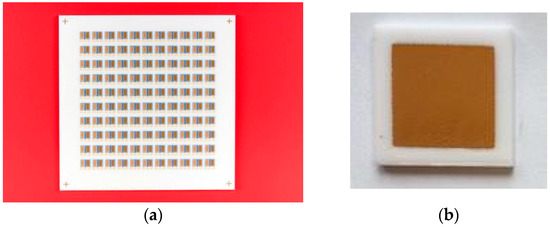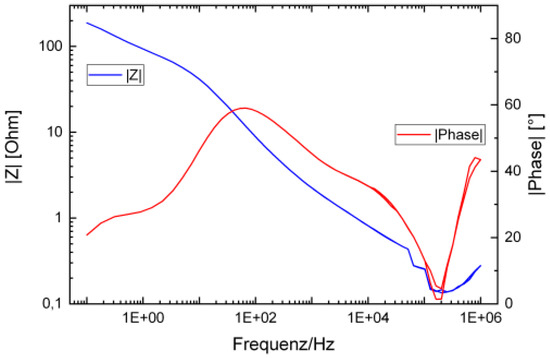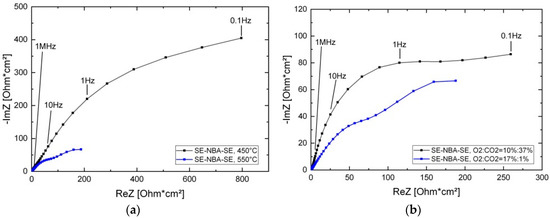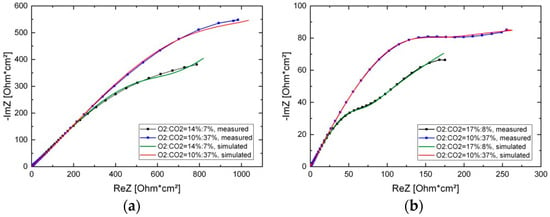Abstract
The electrode processes governing response behavior of a solid electrolyte CO2 sensor have been studied using electrochemical impedance spectroscopy on symmetric cells exposed to various temperatures and gas compositions. It was shown that the electrochemical processes leading to potential formation at the Au/Na2CO3 electrode can be described by adapting models commonly used in the field of molten carbonate fuel cells.
1. Introduction
Carbon dioxide (CO2) is one of the important components in the Earth’s atmosphere. While it is vital for plants and other photosynthetic organisms, it can be toxic for humans at ambient concentrations as low as 1 vol%. CO2 is widely used in industrial processes and, being a combustion product, also contributes to the greenhouse effect. Applications for CO2 detection are numerous: the control of growth processes in biotechnology, air quality monitoring and medical respiratory systems to name just a few. At Fraunhofer IKTS, a potentiometric CO2 sensor based on a sodium-ion conducting solid electrolyte has been developed. The sensor features a large measuring range and is suitable for a wide range of applications. To aid in a systematic approach to sensor optimization, the electrode processes governing sensor response have been studied using electrochemical impedance spectroscopy (EIS) on symmetric cells.
2. Materials and Methods
Miniaturized electrochemical CO2 sensors based on a sodium beta” alumina solid electrolyte (NBA) and carbonate electrodes have been fabricated using thick film technology. The sensors are 3.5 × 4.0 × 1.5 mm3 in size and are operated in potentiometric mode at a temperature of 450–600 °C. While the sensing electrode is based on Na2CO3 and Au, additional SiO2 is used in the reference electrode. Figure 1a shows a multiple panel with 110 miniaturized sensors. To allow for electrode characterization independent of sensor design, symmetric cells with 12 × 12 mm2 sensing electrodes (SE) deposited on NBA have been manufactured (Figure 1b). Prior to electrical characterization, all electrodes were fired at 700–850 °C in air. To determine sensor response to various CO2 contents in synthetic air, the sensors were placed in a sample holder within a tube furnace, electrical connections were made using Au wires and paste. The gas composition was adjusted using mass flow controllers (MKS Instruments, Germany), while a type 2400 source meter (Keithley Instruments / Tektronix, Inc., OR, USA) was used to record the sensor voltage. To obtain precise temperature readings during sensor operation, a Type-S thermocouple was placed close to the sensor, which was read out using an Almemo 2390-3 data logger unit (Ahlborn Mess- und Regelungstechnik, Germany). EIS measurements on symmetric cells exposed to different temperatures and CO2 concentrations have been carried out in a specialized test stand. The samples were allowed 60 min to equilibrate to changes in gas composition. Sample impedance was measured at 10 mHz–1 MHz at open circuit voltage. EIS data acquisition and analysis was performed using a Zennium Electrochemical Workstation and Thales software (Zahner-Elektrik, Germany).

Figure 1.
(a) CO2 sensors on multiple panel, 50 × 50 mm2; (b) Symmetric cell for EIS measurements, 16 × 16 mm2
3. Results and Discussion
3.1. Sensor Characterization
Figure 2a shows the voltage signal of a sensor exposed to CO2 concentrations of 0.02–10 vol% in synthetic air at 500 °C. Aside from signal overshoots after gas concentration changes, which are due to MFC lag and gas mixing, the signal is stable for constant CO2 levels. In Figure 2b, sensor voltage is plotted versus lg(pCO2). Measuring errors are small except for the lowest concentration, where the deviation is large due to MFC error. A fit of the remaining data points yields an almost linear dependence, which in turn means that the signal closely obeys the theoretical Nernstian behavior.

Figure 2.
(a) Signal response of a CO2 sensor; (b) Linear fit of sensor voltage vs. lg(cCO2)
3.2. EIS Measurements
Figure 3 shows a Bode plot of EIS data recorded on a symmetric cell at 500 °C in synthetic air with 1 vol% CO2. In the high frequency region at around 100 kHz, impedance should be controlled mainly by the resistance of the solid electrolyte. Measured values of approximately 0.3 Ohms are in good agreement with 0.32 Ohms obtained from separate electrolyte conductivity measurements. The impedance at low frequencies around 10–100 mHz reflects the relatively slow electrode processes. In Figure 4, two Nyquist plots derived from the measured data are shown. The plots illustrate a distinct dependence of the electrode impedance on both temperature and CO2 concentration. In the high frequency region, the data show an angle of approximately 45° with the ReZ axis, which is usually indicative of diffusion processes. Furthermore, -ImZ increases with decreasing frequency.

Figure 3.
Bode plot of EIS data of symmetric cell SE|NBA|SE (550 °C, synthetic air with 1 vol% CO2)

Figure 4.
Nyquist plots for symmetric cell SE|NBA|SE for (a) CO2/cCO2 = const., (b) T = const.
After data fitting with various model equivalent circuits failed, an analogy to the electrochemical processes at the molten carbonate fuel cell (MCFC) cathode was suggested. The gross reactions at the CO2 sensing electrode (Equation (1)) and the MCFC cathode (Equation (2)) show distinct similarities, the main differences are the solid vs. melt phase and Na+ mobile species as opposed to CO32−:
Na2CO3 ⇄ 2Na+NBA + 2e− + ½O2,g + CO2,g
CO32− ⇄ 2e− + ½O2,g + CO2,g
A model used by Meléndez-Ceballos et al. [1] to describe the oxygen reactions at the MCFC cathode has been adapted to the CO2 sensing electrode. According to this model, the reaction steps at the sensing electrode (Figure 5a) are: (1) Dissolution of CO2 and O2− in Na2CO3, (2) Diffusion of both species to the phase boundary Au-Na2CO3-NBA, (3) Signal-establishing reaction with Na+ ions provided by the NBA solid electrolyte, which is assumed as not being rate-determining due to high diffusivity of Na+ in carbonate and NBA and quick Na+ surface exchange kinetics between carbonate and NBA. In analogy to the rate limiting steps proposed for the MCFC cathode it is assumed that the gross reaction at the CO2 sensing electrode too, is limited by the diffusion of the dissolved O22− species, their reduction to O2− at the TPB and possible O2− neutralization via recombination with CO2 to CO32− as indicated in Figure 5a [1]. To account for all reaction steps, the author of [2] has proposed the equivalent circuit shown in Figure 5b. It features an electrolyte resistance ri, a double layer including a Warburg element (W) to account for diffusion effects, a RC element representing gas adsorption and an additional RC element to describe the neutralization of O2− species. Figure 6 shows Nyquist plots of CO2 sensing electrodes that have been fit using this equivalent circuit. The measured data show a good agreement with the proposed model for different temperatures and O2:CO2 concentration ratios. Resistances, capacitances and further physical properties derived from the fit parameters are of the same order of magnitude as found in literature. Despite this good agreement it was found that Rad decreases with decreasing temperature. This behavior is may be attributed to the fact that the RadCad term doesn’t correspond to real adsorption/desorption processes but rather compensates for the imprecise description of three dimensional O22− diffusion processes in the porous structure by the simplified Warburg impedance expression.

Figure 5.
(a) Model for reactions at the CO2 sensing electrode (b) MCFC cathode equivalent circuit

Figure 6.
EIS data, fit with MCFC cathode model equivalent circuit for (a) 450 °C, (b) 550 °C
4. Conclusions
Miniaturized electrochemical CO2 sensors have been developed at Fraunhofer IKTS. The sensors show good response in a large range of CO2 concentrations and can be adapted for a wide range of applications. For an in-depth study of the sensing mechanism, EIS measurements have been carried out on CO2 sensitive carbonate electrodes in synthetic air at various temperatures and CO2 concentrations. The data are in good agreement with an adapted equivalent circuit model originally derived to describe the electrode reactions at the MCFC cathode. The results suggest that solid phase Na2CO3 may behave similarly as carbonate melts and that diffusion limitation and neutralization of active species could have a significant influence on reaction kinetics and sensor response time.
Author Contributions
S.D. and M.K. conceived sensor design and test procedure, S.M. developed thick film pastes for sensing electrodes, C.B. performed the EIS measurements and contributed to data analysis, M.K. conceived the sensing electrode model, S.D. wrote the paper.
Acknowledgments
The research work presented in this paper has been funded by Bundesministerium für Wirtschaft und Energie, BMWi, Germany.
Conflicts of Interest
The authors declare no conflict of interest. The founding sponsors had no role in the design of the study; in the collection, analyses, or interpretation of data; in the writing of the manuscript, and in the decision to publish the results.
References
- Meléndez-Ceballos, A.; Albin, V. Kinetic approach on the effect of Cs addition on oxygen reduction for MCFC application. Electrochim. Acta 2015, 184, 295–300. [Google Scholar] [CrossRef]
- Bednarz, M. Mechanistische Untersuchung und Modellierung der Kathodenreaktion in Karbonat-brennstoffzellen (MCFC). Ph.D. Thesis, IPCH Universität Hamburg, Hamburg, Germany, 2002. [Google Scholar]
Publisher’s Note: MDPI stays neutral with regard to jurisdictional claims in published maps and institutional affiliations. |
© 2018 by the authors. Licensee MDPI, Basel, Switzerland. This article is an open access article distributed under the terms and conditions of the Creative Commons Attribution (CC BY) license (https://creativecommons.org/licenses/by/4.0/).